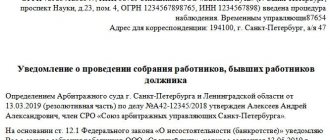Home / Bankruptcy / Bankruptcy of legal entities
Back
Published: 08/18/2019
Reading time: 9 min
0
606
Bankruptcy legislation provides for a simplified procedure for recognizing financial insolvency. The possibility of carrying out bankruptcy under a simplified procedure is provided for individual debtors.
- What is
- What are the differences from a regular bankruptcy procedure?
- Procedure for conducting simplified bankruptcy of a legal entity being liquidated
- Procedure for conducting simplified bankruptcy of an absent legal entity
- Bankruptcy of a specialized company or mortgage agent
- The bankruptcy trustee, his role and powers
What is
Bankruptcy of a legal entity can be carried out in a standard or simplified manner. The method of recognizing financial insolvency and the impossibility of fulfilling one’s debt obligations will be the same in both cases. But simplified bankruptcy is, in fact, a stripped-down version of the procedure.
The simplified bankruptcy procedure is regulated by a separate Chapter 11 in 127-FZ. This Chapter is structurally divided into three paragraphs, which are devoted to:
- Features of bankruptcy of a liquidated debtor.
- Bankruptcy of an absent debtor.
- Bankruptcy of a specialized company or mortgage agent.
The simplified bankruptcy procedure is very common: about half of companies use it. Most often, liquidated and defunct companies go through simplified bankruptcy.
How the auction works
After completion of all the main stages, auctions begin on the debtor’s existing property in order to satisfy at least some part of the existing debts to creditors. In order to sell the property, the bankruptcy trustee holds an auction in which all interested citizens can participate. An exception may be those auctions where goods that are limited in circulation (weapons, precious stones, and so on) are sold.
Bidding under the simplified system is conducted through an electronic platform. In order to become a participant, you must go through a special registration system via the Internet. The winner is the person who offered the highest price for the exhibited goods. Bidding under the simplified system is specifically regulated by law and takes place in 3 stages:
- Primary bidding is the initial stage at which participants can gradually increase the cost of the goods being offered;
- Repeated auctions are held in cases where the primary auctions were declared invalid for one reason or another;
- Public auctions are held when the initial and repeated auctions are not successful and the goods are not sold out. The main feature of this stage is the lowest possible price for goods (up to 99% of the cost).
What are the differences from a regular bankruptcy procedure?
A standard bankruptcy procedure may involve going through 5 stages:
- observation;
- financial recovery;
- external control;
- bankruptcy proceedings;
- settlement agreement.
In simplified bankruptcy, the monitoring procedure or one of the stages of rehabilitation of the debtor is not applied. This is due to the fact that these legal entities are not interested in normalizing the balance of payments. The key purpose of monitoring is to search for reserves to restore solvency, and the purpose of financial recovery and external management is to take measures to get the company out of the financial crisis and prevent its bankruptcy and liquidation.
In simplified bankruptcy, the legal entity is immediately declared bankrupt, and the court introduces a bankruptcy procedure. The standard time frame for closing the register of creditors' claims is 2 months, while in simplified bankruptcy this is given 1 month.
The simplified bankruptcy procedure has the following advantages compared to the standard one:
- It consists of a single stage of bankruptcy proceedings.
- It is carried out as quickly as possible : within 6-9 months, whereas the standard procedure will take 1-2 years.
- It allows you to achieve significant savings on the procedure : up to 30-50%. Such savings are achieved due to the absence of costs for remuneration of temporary, external and arbitration managers, etc.
But the simplified procedure is not without certain disadvantages. The main risk for company participants is the possibility of them being brought to subsidiary liability for the company’s debts as a result of the liquidation of the legal entity.
Is there a difference between bankruptcy and liquidation of an organization?
- The amount of debt obligations differs significantly in these cases: in case of bankruptcy, the debt must be more than 500,000 rubles, in case of voluntary liquidation, at least 50,000 rubles;
- Bankruptcy is a very long procedure, while liquidation through the court takes half as much time;
- The insolvency of a legal entity necessarily implies a thorough financial condition of the debtor; during liquidation this is not necessary;
- Liquidation takes place in just one stage and excludes such stages as observation, external management, financial recovery;
- Liquidation of an enterprise does not involve a bidding procedure as in bankruptcy - property can be sold to any person.
Bankruptcy proceedings have serious consequences compared to liquidation. If, during the bankruptcy procedure, the court establishes deliberate or fictitious actions, the applicant may be held administratively or criminally liable for false information and misleading the court.
When carrying out the liquidation procedure, the court appoints a responsible person - the liquidator, who then creates a liquidation commission for all existing issues. After which, all existing debts are written off from the organization and changes are made to the Unified State Register of Legal Entities extract stating that the person is ceasing its activities, after which a state certificate of closure of the company is issued.
Thus, bankruptcy and liquidation procedures differ significantly from each other, primarily in that liquidation is less time-consuming and nerve-wracking for the applicant. Insolvency requires many more actions and demands from its applicant. Therefore, if the applicant has legal grounds for liquidating the company, then it is better to go through this procedure, since insolvency will take much more time and effort.
Procedure for conducting simplified bankruptcy of a legal entity being liquidated
The bankruptcy of a liquidated debtor involves going through the following stages:
- The founders of the company decide on the upcoming liquidation . To do this, a meeting of the founders is held, which must unanimously come to a decision to close the company.
- A liquidation commission or a single liquidator is appointed . The decision on liquidation is submitted to the Federal Tax Service within 3 days. Based on the results of the decision, a message about the upcoming liquidation of the legal entity is published in the Unified State Register of Legal Entities.
- The liquidation commission publishes in the State Registration Bulletin a message about the upcoming liquidation and the procedure for presenting creditor claims.
- An interim liquidation balance sheet is compiled based on the results of received creditor claims . If, based on its results, it was revealed that the property was insufficient to repay all creditors’ claims, then the liquidation process should be suspended.
- The debtor must submit an application for bankruptcy to the arbitration court . In this case, declaring bankruptcy is the duty of the debtor, and not his right: if he neglects this duty, he will be refused to make an entry in the Unified State Register of Legal Entities about the upcoming closure. Also, a bankruptcy application can be submitted to a bankruptcy creditor: if the amount of debt exceeds 300 thousand rubles, and the arrears on obligations are 3 months.
- Before applying to arbitration, the liquidated debtor must publish a notice of this in the State Registration Bulletin at least 15 days in advance . The application itself is submitted to the court no later than 10 days after signs of bankruptcy are discovered.
- Based on the results of the court hearing, a decision will be made as to whether the bankruptcy application is justified . If the court recognizes the presence of signs of insolvency, then it issues a ruling on the introduction of bankruptcy proceedings.
- A bankruptcy trustee is appointed.
- The manager publishes a message about the introduction of bankruptcy proceedings in the Kommersant newspaper and the EFRSB.
- The manager is obliged to notify creditors about the opening of bankruptcy proceedings.
- Creditors will have 1 month to submit their claims to be included in the register.
- A bankruptcy estate is formed , and the company's property is put up for auction.
- Based on the results of the formation of the bankruptcy estate, the manager proceeds to repay the creditors' claims . These claims are settled in the standard order of priority. First of all, the claims of creditors to whom the debtor has obligations for causing harm to life and health are subject to satisfaction, secondly - arrears of wages and severance pay, thirdly - debt obligations to bankruptcy creditors and authorized bodies. Obligations for current payments, debt in terms of procedural and legal costs (for example, costs of publishing mandatory messages, organizing tenders, etc.) are repaid in an extraordinary manner.
- If the company's property was not enough to pay off all obligations, then the creditors' claims are repaid in proportion to their share in the total debt . Claims outstanding as a result of the procedure are written off and the debtor is liquidated.
- The arbitration manager prepares reports on the effectiveness of the bankruptcy procedure.
- If the manager's report on the results of bankruptcy is accepted, the court issues a ruling on the completion of bankruptcy proceedings . This determination is forwarded to the Federal Tax Service, and it becomes the basis for making a record of the liquidation of the legal entity in the Unified State Register of Legal Entities.
After a note on the liquidation of a legal entity has been entered into the Unified State Register of Legal Entities, the company is considered to have officially ceased its activities. She must destroy the seal, close all owned accounts and transfer all necessary documentation to the archives.
Checking liquidation information
Indeed, Diamond Electric LLC (OGRN 1047796635457) is in a state of liquidation. This information is contained in the unified state register of legal entities.
The date that is important for you is 04/29/2020. On this day, a message about the liquidation of Diamond Electric LLC was published in the official printed publication “Bulletin of State Registration”.
Taking into account the two-month period specified in the specified message, you need to submit your monetary claims to the liquidator no later than 06/29/2020 inclusive.
But most importantly, even if you submit your demands on time, you must very carefully monitor the further fate of the liquidated debtor until you receive your money from him.
During the period specified in the liquidation notice (in your case, this is the period from 04/29/2020 to 06/29/2020), the liquidator collects the claims of creditors, verifies them with accounting data, and consolidates them into an interim liquidation balance sheet, in accordance with which further payments are made creditors.
According to Article 63 of the Civil Code of the Russian Federation, from the date of approval of the interim liquidation balance sheet, settlements with creditors are carried out in order to ultimately approve a “zero” liquidation balance sheet. This is where there can be pitfalls.
Procedure for conducting simplified bankruptcy of an absent legal entity
The procedure for simplified bankruptcy of a liquidated debtor has some features. An application for declaring a company bankrupt in the case under consideration is submitted:
- bankruptcy creditor.
- The authorized body represented by the tax or prosecutor's office.
An application to declare a company bankrupt must be submitted subject to the following conditions:
- The citizen-debtor is absent or it is impossible to determine his whereabouts.
- The volume of property owned by the debtor does not provide him with the opportunity to cover the costs of the court procedure to consider the bankruptcy case.
- Absence of transactions on the company's accounts during the year before filing an application to declare the legal entity financially insolvent.
- The presence of other conditions that indicate the absence of entrepreneurial and other activities on the part of the debtor.
Also, the responsibilities of the temporary manager at the observation stage include filing a petition to switch to simplified bankruptcy if signs of an absent debtor are detected. Thus, even if the bankruptcy procedure initially began in a standard manner, a transition to a reduced format is permissible.
The bankruptcy case of an absent debtor is considered within a month in an arbitration court.
But if the debtor discovered property during the process, then the court proceeds to standard bankruptcy.
After which a simplified scheme begins to be introduced
After it has been established in arbitration that a person does not have the financial ability to pay off debts to creditors, simplified bankruptcy is introduced.
However, it can be applied exclusively to the following categories of persons: 1. Legal entities that, due to their financial insolvency, actually do not have the opportunity to pay off their debts (in this case, the existing movable and immovable property of the liquidated debtor is taken into account, which may be due to pay off a debt).
In this case, the initiator can be either the founder of the company or the manager (Director, Manager, President, etc.). After acceptance of the application from these persons, bankruptcy proceedings are introduced. Creditors have the right to present their claims within one month by filing a written complaint with the court, motivating their demands.
2. Legal entities that have actually stopped operating on the market, or companies whose founder and director cannot be found. The initiator in this case can be any person who was directly in some way financially connected with the debtor (creditors, tax inspectorate, bailiffs, and so on).
A feature of the simplified procedure is that the debtor does not have the financial ability to fulfill his debts. Therefore, if during bankruptcy proceedings the court determines that the debtor has property that can be used to pay off the debt, then the general bankruptcy procedure will be applied to the debtor.
Bankruptcy of a specialized company or mortgage agent
Specialized organizations are understood as financial organizations, as well as project finance institutions. These organizations are engaged in the collection of debt obligations and the redirection of funds for the implementation of investment projects through the purchase of monetary claims for obligations associated with the sale of property created during the implementation of such projects. An application for bankruptcy of an organization is submitted by the owner of the securities based on a decision of the general meeting of owners.





